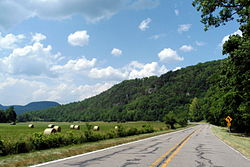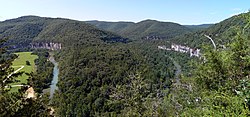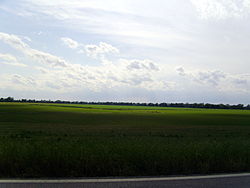Arkansas
Arkansas is a state in the United States of America. Its capital and largest city is Little Rock. It is considered part of the South, and is bordered by Oklahoma to the west, Missouri to the north, Tennessee and Mississippi to the east, Louisiana to the south, and its southwestern corner touches Texas. The 2020 census counted 3,013,756 people living in Arkansas.[8]
| Arkansas state symbols | |
|---|---|
 | |
 | |
| Living insignia | |
| Bird | Mockingbird |
| Butterfly | Diana fritillary |
| Flower | Apple blossom |
| Insect | Western honeybee |
| Mammal | White-tailed deer |
| Tree | Pine tree |
| Inanimate insignia | |
| Beverage | Milk |
| Dance | Square dance |
| Food | Pecan |
| Gemstone | Diamond |
| Mineral | Quartz |
| Rock | Bauxite |
| Soil | Stuttgart |
| Other | South Arkansas vine ripe pink tomato (state fruit and vegetable) |
| State route marker | |
 | |
| State quarter | |
 Released in 2003 | |
| Lists of United States state symbols | |
History
Arkansas became the 25th state to enter the Union in 1836. During the American Civil War, Arkansas was one of the Confederate states. Afterward, during Reconstruction, it was the second state to be reintegrated into the U.S. Native Americans first settled in the state before the arrival of Europeans. Many enslaved Africans and their descendants were forcibly brought to Arkansas during the Transatlantic slave trade.
Geography
View from the summit of Petit Jean Mountain, in the Arkansas River Valley, from Mather Lodge in Petit Jean State Park.
The Ouachita River runs through the Ouachita National Forest.
Blanchard Springs Caverns in Stone County is a popular tourist destination.
The Buffalo National River, one of many attractions that give the state's nickname The Natural State.
Arkansas has many rivers, lakes, and reservoirs. Arkansas has few natural lakes but many reservoirs such as Bull Shoals Lake, Lake Ouachita, Greers Ferry Lake, Millwood Lake, Beaver Lake, Norfork Lake, DeGray Lake, and Lake Conway.[9]
Arkansas is home to many caves, such as Blanchard Springs Caverns. More than 43,000 Native American living, hunting and tool making sites have been catalogued by the State Archeologist. Arkansas is currently the only U.S. state in which diamonds are mined. This is done by members of the public with primitive digging tools for a small daily fee, not by commercial interests.[10][11]
Arkansas is home to a bunch of wood Areas adding around 150,000 acres (610 km2). These areas are set for outdoor playing and are open to hunting, fishing, hiking, and camping. No vehicles are able to drive in these areas.
Religion

Arkansas, like most other Southern states, is part of the Bible Belt. It is mostly Protestant. The largest denominations by number of followers in 2000 were the Southern Baptist Convention with 665,307; the United Methodist Church with 179,383; the Roman Catholic Church with 115,967; and the American Baptist Association with 115,916.[12]
Education
Education in Arkansas has been an issue. Part of the problem has been low teacher salaries and small budgets for spending on students. Other problems have been not wanting to integrate, and poor school facilities.[13]
Arkansas has two university systems: Arkansas State University System and University of Arkansas System. Some other public institutions are Arkansas Tech University, Henderson State University, Southern Arkansas University, and University of Central Arkansas. It is also home to 11 private colleges and universities. One of them being Hendrix College, one of the nation's top 100 liberal arts colleges, according to U.S. News & World Report.[14]
Culture
Arkansas is liked for its bauxite mines. Arkansas was also the first U.S. state where diamonds were found. Liked Arkansans are Bill Clinton, who was governor of Arkansas before he became the President of the United States, Sam Walton, the CEO of Wal-Mart, Johnny Cash, a famous guitar player known as "The Man In Black".
Attractions
Arkansas is home to many areas protected by the National Park System. These include:[15]
- Arkansas Post National Memorial at Gillett
- Buffalo National River
- Fort Smith National Historic Site
- Hot Springs National Park
- Little Rock Central High School National Historic Site
- Pea Ridge National Military Park
- President William Jefferson Clinton Birthplace Home National Historic Site
- Clinton House Museum
Arkansas Media
Platform mounds were constructed frequently during the Woodland and Mississippian periods.
Map of the Arkansas Territory
Arkansas statehood, 100th anniversary issue; released on June 15, 1936, on the 100th anniversary of Arkansas statehood. The old state house is depicted at center, the fort surrounding the Arkansas Post at left with the present day state capitol building at right.
Lakeport Plantation, built c. 1859
Cannons at Battle of Pea Ridge site
A group of African American boys in Little Rock in 1938.
View from the Ozark Highlands Scenic Byway in Boxley Valley
The Ozarks rise behind a bend in the Buffalo River from an overlook on the Buffalo River Trail.
The flat terrain and rich soils of the Arkansas Delta near Arkansas City are in stark contrast to the northwestern part of the state.
Related pages
Notes
- ↑ 1.0 1.1 Elevation adjusted to North American Vertical Datum of 1988.
- ↑ The Geographic Names Index System (GNIS) of the United States Geological Survey (USGS) indicates that the official name of this feature is Magazine Mountain, not "Mount Magazine". Although not a hard and fast rule, generally "Mount X" is used for a peak and "X Mountain" is more frequently used for ridges, which better describes this feature. Magazine Mountain appears in the GNIS as a ridge,[3] with Signal Hill identified as its summit.[4] "Mount Magazine" is the name used by the Arkansas Department of Parks and Tourism, which follows what the locals have used since the area was first settled.
References
| Wikimedia Commons has media related to Lua error in Module:Commons_link at line 62: attempt to index field 'wikibase' (a nil value).. |
- ↑ "Mag". NGS data sheet. U.S. National Geodetic Survey. http://www.ngs.noaa.gov/cgi-bin/ds_mark.prl?PidBox=FG1888.
- ↑ 2.0 2.1 "Elevations and Distances in the United States". United States Geological Survey. 2001. Archived from the original on October 15, 2011. Retrieved October 21, 2011.
- ↑ [[[:Template:GNIS 3]] "Magazine Mountain"]. Geographic Names Information System. United States Geological Survey. Retrieved January 2, 2013.
{{cite web}}: Check|url=value (help) - ↑ [[[:Template:GNIS 3]] "Signal Hill"]. Geographic Names Information System. United States Geological Survey. Retrieved January 2, 2013.
{{cite web}}: Check|url=value (help) - ↑ "US Census Bureau QuickFacts". Retrieved April 30, 2022.
- ↑ Blevins 2009, p. 2.
- ↑ "2020 Arkansas Code Title 1 - General Provisions Chapter 4 - State Symbols, Motto, Etc. § 1-4-117. Official language". Justia US Law. Retrieved April 27, 2023.
- ↑ Cite error: Invalid
<ref>tag; no text was provided for refs namedBureau 2021. - ↑ Smith, Richard M. (1989). The Atlas of Arkansas. The University of Arkansas Press. p. 25. ISBN 978-1-55728-047-3.
- ↑ "Crater of Diamonds: History of diamonds, diamond mining in Arkansas". Craterofdiamondsstatepark.com. Archived from the original on August 21, 2010. Retrieved July 30, 2010.
- ↑ "US Diamond Mines – Diamond Mining in the United States". Geology.com. Archived from the original on July 24, 2010. Retrieved July 30, 2010.
- ↑ "The Association of Religion Data Archives | Maps & Reports". Thearda.com. Archived from the original on May 10, 2008. Retrieved July 30, 2010.
- ↑ Goodwyn, Lawrence; Books, Time-Life. The Shouth Central States Arkansas, Louisiana, Oklahoma, Texas. Taylor & Francis. p. 122.
- ↑ National Liberal Arts College Rankings. U.S. News & World Report. 2012. http://colleges.usnews.rankingsandreviews.com/best-colleges/rankings/national-liberal-arts-colleges. Retrieved September 3, 2012.
- ↑ "Arkansas". National Park Service. Retrieved July 15, 2008.
















